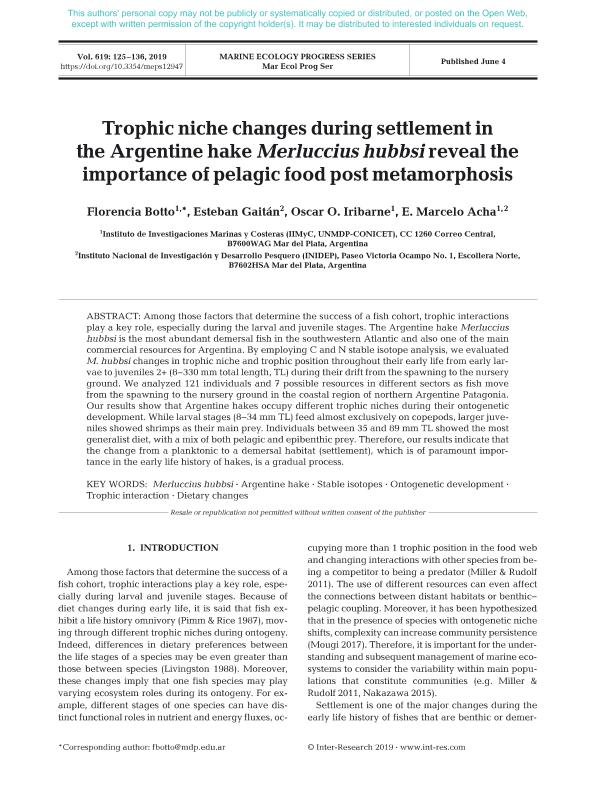Artículo
Trophic niche changes during settlement in the Argentine hake Merluccius hubbsi reveal the importance of pelagic food post metamorphosis
Fecha de publicación:
06/2019
Editorial:
Inter-Research
Revista:
Marine Ecology Progress Series
ISSN:
0171-8630
Idioma:
Inglés
Tipo de recurso:
Artículo publicado
Clasificación temática:
Resumen
Among those factors that determine the success of a fish cohort, trophic interactions play a key role, especially during the larval and juvenile stages. The Argentine hake Merluccius hubbsi is the most abundant demersal fish in the southwestern Atlantic and also one of the main commercial resources for Argentina. By employing C and N stable isotope analysis, we evaluated M. hubbsi changes in trophic niche and trophic position throughout their early life from early larvae to juveniles 2+ (8−330 mm total length, TL) during their drift from the spawning to the nursery ground. We analyzed 121 individuals and 7 possible resources in different sectors as fish move from the spawning to the nursery ground in the coastal region of northern Argentine Patagonia. Our results show that Argentine hakes occupy different trophic niches during their ontogenetic development. While larval stages (8−34 mm TL) feed almost exclusively on copepods, larger juveniles showed shrimps as their main prey. Individuals between 35 and 89 mm TL showed the most generalist diet, with a mix of both pelagic and epibenthic prey. Therefore, our results indicate that the change from a planktonic to a demersal habitat (settlement), which is of paramount importance in the early life history of hakes, is a gradual process.
Archivos asociados
Licencia
Identificadores
Colecciones
Articulos(IIMYC)
Articulos de INSTITUTO DE INVESTIGACIONES MARINAS Y COSTERAS
Articulos de INSTITUTO DE INVESTIGACIONES MARINAS Y COSTERAS
Citación
Botto, Florencia; Gaitán, Esteban Nicolás; Iribarne, Oscar Osvaldo; Acha, Eduardo Marcelo; Trophic niche changes during settlement in the Argentine hake Merluccius hubbsi reveal the importance of pelagic food post metamorphosis; Inter-Research; Marine Ecology Progress Series; 619; 6-2019; 125-136
Compartir
Altmétricas




